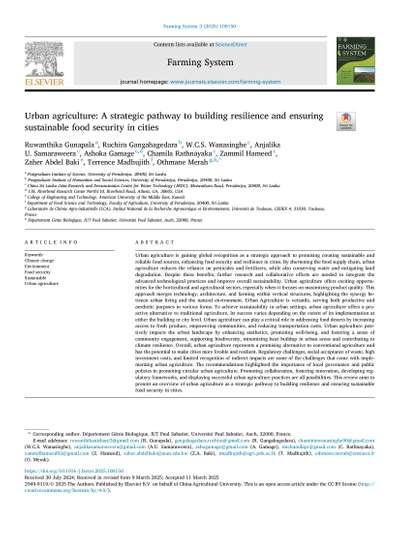Farming System Urban agriculture: A strategic pathway to building resilience and ensuring sustainable food security in cities
Published: 20/01/2025

Ruwanthika Gunapala, Ruchira Gangahagedara, W.C.S. Wanasinghe, Anjalika U. Samaraweera, Ashoka Gamage, Chamila Rathnayaka, Zammil Hameed, Zaher Abdel Baki, Terrence Madhujith, Othmane Merah, Urban agriculture: A strategic pathway to building resilience and ensuring sustainable food security in cities, Farming System, Volume 3, Issue 3, 2025, 100150, ISSN 2949-9119, https://doi.org/10.1016/j.farsys.2025.100150. (https://www.sciencedirect.com/science/article/pii/S2949911925000140)
Abstract: Urban agriculture is gaining global recognition as a strategic approach to promising creating sustainable and reliable food sources, enhancing food security and resilience in cities. By shortening the food supply chain, urban agriculture reduces the reliance on pesticides and fertilizers, while also conserving water and mitigating land degradation. Despite these benefits, further research and collaborative efforts are needed to integrate the advanced technological practices and improve overall sustainability. Urban agriculture offers exciting opportunities for the horticultural and agricultural sectors, especially when it focuses on maximizing product quality. This approach merges technology, architecture, and farming within vertical structures, highlighting the synergy between urban living and the natural environment. Urban Agriculture is versatile, serving both productive and aesthetic purposes in various forms. To achieve sustainability in urban settings, urban agriculture offers a proactive alternative to traditional agriculture. Its success varies depending on the extent of its implementation at either the building or city level. Urban agriculture can play a critical role in addressing food deserts by increasing access to fresh produce, empowering communities, and reducing transportation costs. Urban agriculture positively impacts the urban landscape by enhancing aesthetics, promoting well-being, and fostering a sense of community engagement, supporting biodiversity, minimizing heat buildup in urban areas and contributing to climate resilience. Overall, urban agriculture represents a promising alternative to conventional agriculture and has the potential to make cities more livable and resilient. Regulatory challenges, social acceptance of waste, high investment costs, and limited recognition of indirect impacts are some of the challenges that come with implementing urban agriculture. The recommendations highlighted the importance of local governance and public policies in promoting circular urban agriculture. Promoting collaboration, fostering innovation, developing regulatory frameworks, and displaying successful urban agriculture practices are all possibilities. This review aims to present an overview of urban agriculture as a strategic pathway to building resilience and ensuring sustainable food security in cities.
Keywords: Climate change; Environment; Food security; Sustainable; Urban agriculture